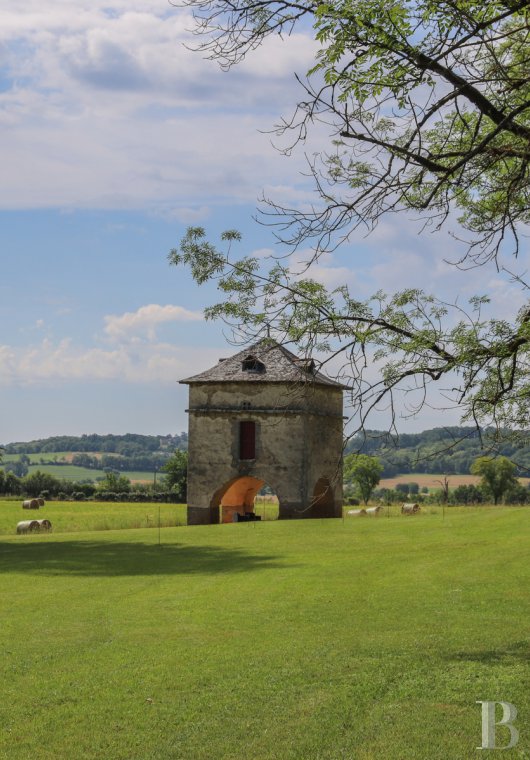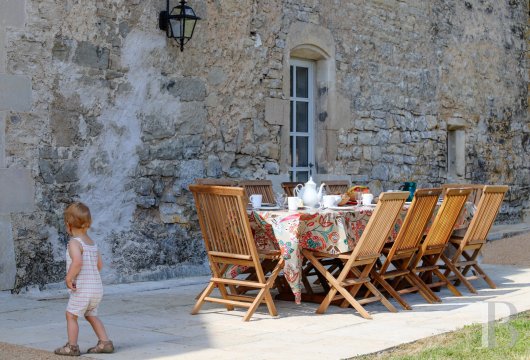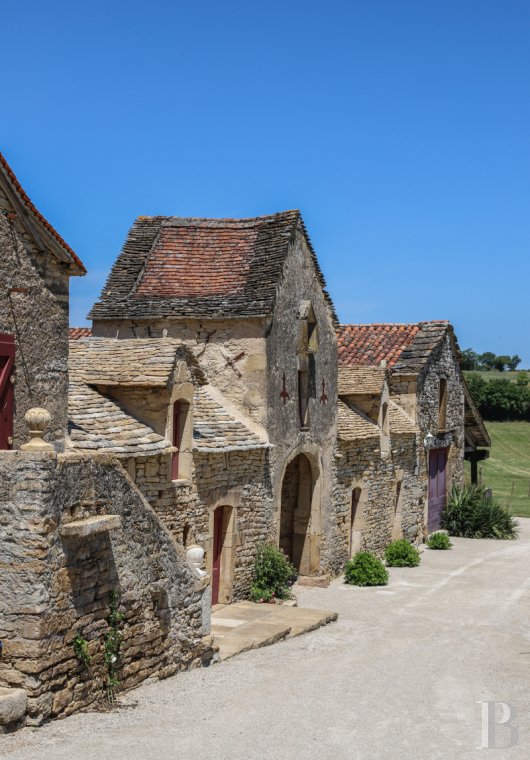Add to favorites
Log in to your personal space

Amid the gentle undulations of the Rouergue landscape that sweep the view into the distance, Cambayrac has stood here for centuries. The old chateau topped with slate has lost none of its watchtower allure. This touch of austerity hints at the harsh lives lived by the lords of the past who were knights and ploughmen all at once. Surrounded by a carefully manicured park home to a huge cedar tree, the property now watches over happy days, welcoming visitors with all the refinement of a family home recently adorned with modern day comforts. In such an enchanting place, it is nothing short of a pleasure to follow in the footsteps of a long dynasty, and nonetheless feel at home during your stay.
My husband is originally from this region, but we had been living in Toulouse for a few years. It was whilst relocating that we arrived, somewhat by chance, in Tarn-et-Garonne in 2017. We settled in the Cambayrac estate which belonged to the Armagnac de Castanet family for several centuries. My in-laws had already been working on an extensive restoration of the chateau for several years and we supported them in this adventure, until the end of the work in 2021.

The configuration of the Cambayrac estate is particularly interesting: there is a 16th century chateau, but also an old 17th century chapel, outbuildings, a dovecote, a remarkable 18th century farmhouse on a square courtyard and a 19th century granary. This is how the property earned its place, in its entirety, in the list of Historic Monuments in 2006 as an authentic testimony of rural vernacular architecture. In accordance with the fortified houses and lairs in Rouergue, the construction of the Château de Cambayrac dates back to the second half of the 16th century. It is a simple construction based on a rectangular plan with a staircase tower serving as the entrance. Both limestone and sandstone blocks were used, as well as dressed stone for the window frames and corners. Some vestiges of the original construction are still visible. Of particular note is the first main building which most probably dates back to the second half of the 15th century - the latrines are still visible on the west gable, and the windows (now filled) are visible on the east gable and the north wall.
This estate is linked to the history of the Seigneury of Castanet (owned by a feudal family known since the 13th century) which it has been a part of since the very beginning. It was an agricultural estate that became the property of Pierre d'Armagnac, a knight belonging to a younger branch of the sovereign counts of Armagnac, during his marriage to Réale de Faudoas (heiress of the Seigneury of Castanet) in 1377. The last representative of the Castanets, Guyon, had in fact died without a direct heir in 1375. Cambayrac first appears in the archives in 1452, through a long-term lease given by Arnaud de Castanet. In 1585, Cambayrac was bequeathed to Georges de Castanet who made it his ordinary residence. Despite the estate being confiscated during the Revolution, the widow of François de Castanet later bought it back and their children regained use of it under the Restoration. The most recent inhabitants - my husband's uncle and aunt - disappeared in the 1990s. Thirty years later, the estate is experiencing a true renaissance having been elegantly restored and decorated.
A comfortable, charming residence on a human scale, with six bedrooms, five bathrooms and spacious rooms. The history of the old stones can be felt all around, it blends harmoniously with a feeling of great comfort thanks to the high-quality renovations that gave pride of place to noble materials such as travertine and lime-cement plaster. The wooded park, nestled in the Rouergue countryside, is the perfect setting for rejuvenating holidays with family or friends. Guests can spend their time by the pool or strolling in the woods of the estate which are open to all. Cambayrac is a place for relaxation, sharing good times with loved ones, and basking in the calm of nature and the joy of coming together. A large library, board games and outdoor games (pétanque, badminton, table tennis) are available. A beautiful 60m² room surrounded by the framework of the chateau can accommodate celebratory meals. Our partner caterer serves local dishes adjusted to your tastes.

The estate is located at the crossroads of Tarn-et-Garonne, Aveyron, Lot and Tarn. There are countless sublime and well-preserved spots for cultural, sporting and gastronomic escapades! Food lovers will be won over by Jacques Carles' Farm, he is a colourful character who shows visitors around his traditional duck farm before serving an incredible meal. A trip to the Anawim convent, where two nuns are at work, is also a must to try his delicious goat's cheese. Organic vegetables can be found at the Jardin d'Odette in town. The markets here are an institution: Thursday is Villefranche-de-Rouergue, Friday is Parisot, and Sunday is Saint-Antonin-Noble-Val. We like to canoe as a family in the Aveyron gorges and stroll around Lake Parisot (just three kilometres from the chateau) to enjoy a relaxing view and a swim followed by an excellent seasonal meal at the Poissons Volants. Antique hunting in Entre Cour et Jardin, an antique store full of gems in Saint-Antonin-Noble-Val, is not to be missed. The same goes for Kraft, a pop-up store in Villefranche-de-Rouergue that exhibits the creations of local artisans throughout the summer and in December.

Professionals have access to the chateau, the park, the woods, and the exteriors of the outbuildings (farmhouse and dovecote). Accommodation can be provided in the six rooms of the chateau. Other gîtes and guesthouses are available in the nearby hamlet of Cambayrac.
ref 711507

 A link to enter a new password has been sent to you by email.
A link to enter a new password has been sent to you by email.
By continuing your navigation, you accept the use of cookies to offer you services and offers adapted to your centers of interest and to measure the frequentation of our services. Learn more